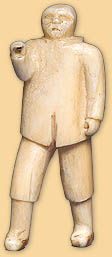 |
Sergeant J. E. F. Wight joined the Royal Northwest Mounted Police
in 1914 and retired from the force in 1945. He spent most of his service
in the police force in Canada's North, with his last posting in
Chesterfield Inlet. During his stay in Pangnirtung from 1924 to 1925,
he went on patrols by boat and by dogsled, reports of which have been
published.*
In 1989, his son Daniel Wight donated a set of ivories to the
Canadian Museum of Civilization. It appears his father collected these
in Chesterfield Inlet around 1936.
*A. E. Millward, ed.
1930 – Southern Baffin Island: An Account of Exploration,
Investigation and Settlement during the Past Fifty Years. Ottawa:
Department of the Interior, pp. 62-67.
Model Sled with Three Dogs, circa 1936
Chesterfield Inlet, Nunavut
Ivory, sealskin, black colouring
Sled: 2.3 x 19.5 x 6.9 cm
CMC IV-C-5576
Gift of Daniel Wight, Pitt Meadows, B.C., 1989
Collected by Sergeant J. E. F. Wight while stationed at the Chesterfield
Inlet RCMP detachment
|
 |
Model sleds like this must have been popular among the RCMP personnel
in the North. They served as souvenirs of their hazardous patrols to
Inuit camps which were part of the RCMP's responsibility. In times of
poor fox harvests or bad hunting weather, the RCMP were authorized to
issue Inuit with a government sick and destitute allowance.
Model Boat with Four Paddles, circa 1936
Chesterfield Inlet, Nunavut
Ivory, cotton
23 x 31 x 5.5 cm
CMC IV-C-5584
Gift of Daniel Wight, Pitt Meadows, B.C., 1989
Collected by Sergeant J. E. F. Wight while stationed at the Chesterfield
Inlet RCMP detachment
|
 |
Models of items used daily in Inuit life were not restricted to
"traditional" objects. This wooden boat is clearly of European
origin and design – a rowboat with a sail attached. Note the small ivory
rings which were no doubt carved with a pocket knife as the main tool.
 |
|
Button, 1936
Chesterfield Inlet, Nunavut
Ivory, black colouring
1 x 2.9 x 3 cm
CMC IV-C-5580
Gift of Daniel Wight, Pitt Meadows, B.C., 1989
|
 |
In traditional Inuit culture, men had to fashion all their tools
by hand and each hunter had to be technologically autonomous. Ivory
was used to carve small utilitarian objects, such as toggles for
dogs' harnesses, handles for whips and other tools. The use of ivory
for small fittings was extended to Euro-Canadian objects such as buttons
for coats and jackets.
Hunter with Raised Right Arm,
circa 1936
Chesterfield Inlet, Nunavut
Ivory
7.6 x 2.4 x 2.5 cm
CMC IV-C-5572
Gift of Daniel Wight, Pitt Meadows, B.C., 1989
Collected by Sergeant J. E. F. Wight while stationed at the RCMP
detachment in Chesterfield Inlet
|
 |
 |
The raised arm probably held a harpoon at one time. The figure,
with its stylized clothing and showing a person in action, bears a
strong resemblance to the figures that A. P. Low and Captain Comer
collected in this area 30 years earlier.
|